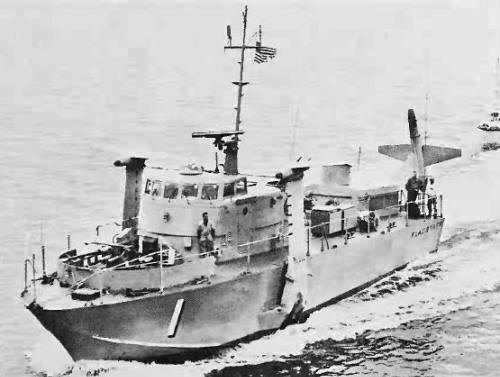
NAVYPEDIA
 Support the project with paypal
Support the project with paypal
Photo

Flagstaff 1970, foils retracted
Ships
| Names | Builders | Commissioned | Losses | Transfers | Discarding |
|---|---|---|---|---|---|
PGH1, 11.1974- WPBH1, 2.1975- PGH1, 9.1976- WPBH1 Flagstaff |
Grumman, Stuart: PGH1 Flagstaff |
9/1968: PGH1 Flagstaff |
none |
none |
9.1978: WPBH1 Flagstaff |
Technical data
| Displacement standard, t | 57 |
|---|---|
| Displacement full, t | 67 |
| Length, m | 22.7 |
| Breadth, m | 6.50 |
| Draught, m | 4.10 (foils extended) / 1.30 (foils retracted) |
| No of shafts | 1 shaft (for foil-borne) / 2 water-jets (for hull-borne) |
| Machinery | CODOG: 1 Rolls-Royce Tyne gas turbine (foil-borne) / 2 General Motors diesels (hull-borne) |
| Power, h. p. | 3620 / 300 |
| Max speed, kts | 48 / 8 |
| Fuel, t | diesel oil |
| Endurance, nm(kts) | |
| Armament | 1 x 1 - 40/60 Mk 3, 2 x 2 - 12.7/90, 1 x 1 - 81/12 M29 mortar |
| Electronic equipment | radar |
| Complement | 13 |
Graphics
Project history
By the early 1960s interest had shifted towards the fast gunboat role, and it appeared that a relatively small hydrofoil could duplicate many of the qualities of the larger Asheville class fast gunboat. Two competitive prototypes were built under the FY66 (SCB 252) programme; the Grumman Flagstaff and the Boeing Tucumcari. At one time a follow-on class of thirty-four hydrofoils was planned, with features borrowed from both. They differed largely in propulsion, Grumman using a geared propeller with the main lifting surface forward; Boeing, water-jets with the main foil surfaces aft. Both were tested in Vietnam, returning home in 1970. Originally armed with 40mm gun forward.
Modernizations
1971 (temporarily for tests): - 1 x 1 - 40/60; + 1 x 1 -152/12 M81E1 tank gun
1974: armament consisted from small arms only
Naval service
: Flagstaff was badly damaged in collision with a whale and was sold in 1978.
© Ivan Gogin, 2015
 HOME
HOME FIGHTING SHIPS OF THE WORLD
FIGHTING SHIPS OF THE WORLD UNITED STATES OF AMERICA
UNITED STATES OF AMERICA COASTAL FORCES
COASTAL FORCES FLAGSTAFF gun hydrofoil (1968)
FLAGSTAFF gun hydrofoil (1968)
